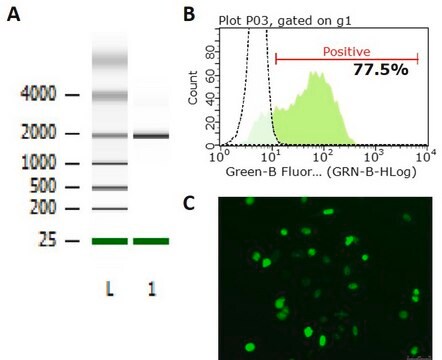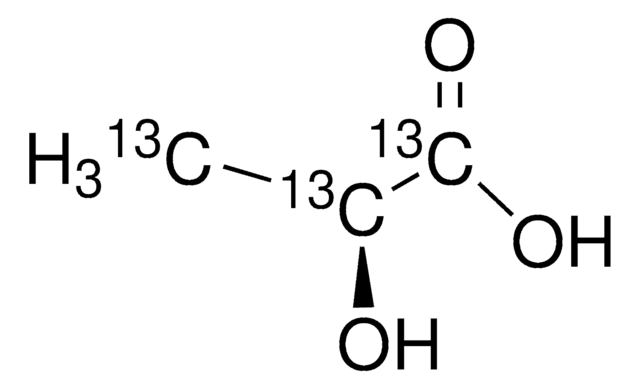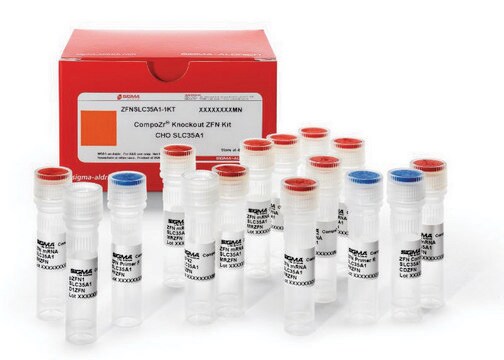Kluczowe dokumenty
CSTZFN
CompoZr® Custom Zinc Finger Nuclease (ZFN)
ZFN plasmid and mRNA
Synonim(y):
Zinc Finger Nuclease
About This Item
Polecane produkty
Szukasz podobnych produktów? Odwiedź Przewodnik dotyczący porównywania produktów
Powiązane kategorie
Opis ogólny
Zastosowanie
- Creation of gene knockouts in multiple cell lines
- Complete knockout of genes not amenable to RNAi
- Creation of knock-in cell lines with promoters, fusion tags or reporters integrated into endogenous genes
- Creation of cell lines that produce higher yields of proteins or antibodies
Cechy i korzyści
- Rapid design, assembly, and validation of a ZFN pair targeting your gene of interest
- Rapid and permanent disruption of, or integration into, any genomic loci
- Mutations made are permanent and heritable
- Works in a variety of mammalian somatic cell types
- Edits induced through a single transfection experiment
- Knockout or knock-in cell lines in as little as two months
- Single or biallelic edits occur in 1-20% of clone population
- No antibiotic selection required for screening
Komponenty
- Best Performing ZFN Pair
- 10 Aliquots of Ready-to-Deliver ZFN Pair in mRNA form
- ZFN Pair in Plasmid Form
- Forward and Reverse Primers that allow for determination of rate of mutation and for screening of individual clones
- Positive Control DNA
- Used to determine a baseline cutting efficiency
Inne uwagi
Custom ZFN Service offering HERE
Informacje prawne
produkt powiązany
Kod klasy składowania
10 - Combustible liquids
Temperatura zapłonu (°F)
Not applicable
Temperatura zapłonu (°C)
Not applicable
Wybierz jedną z najnowszych wersji:
Certyfikaty analizy (CoA)
Przepraszamy, ale COA dla tego produktu nie jest aktualnie dostępny online.
Proszę o kontakt, jeśli potrzebna jest pomoc Obsługa Klienta
Masz już ten produkt?
Dokumenty związane z niedawno zakupionymi produktami zostały zamieszczone w Bibliotece dokumentów.
Produkty
Deciphering the genetics of neuroscience has always been challenging. Heterogeneous tissue microenvironments, complex genetic interactions and phenotypes, lack of model systems that accurately mimic the human brain transcriptome - not to mention the blood-brain barrier - make genetic perturbation analysis difficult in neural tissues.
Nasz zespół naukowców ma doświadczenie we wszystkich obszarach badań, w tym w naukach przyrodniczych, materiałoznawstwie, syntezie chemicznej, chromatografii, analityce i wielu innych dziedzinach.
Skontaktuj się z zespołem ds. pomocy technicznej








